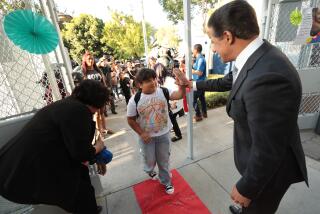A Trying Rite of Spring: Exams at Public Schools
- Share via
It’s that time again in California. About 4.8 million public school students are sharpening their No. 2 pencils and taking standardized tests in math, English, science and other subjects.
The annual testing rite is in full swing until mid-May for most schools in the state, although some year-round campuses will be giving exams as late as July.
Students are spending up to 16 hours answering multiple-choice questions and writing English essays. For them and their schools, the stakes are high.
Flagging test results at some campuses serving disadvantaged children could ultimately cost teachers and principals their jobs under the federal No Child Left Behind education law. It requires schools to regularly show improvement or face possible sanctions such as the removal of staff.
Although testing is dominating the agendas of teachers and principals, education officials say the exams are taking up only about 1% of the time students spend in class this year.
“Folks think we do nothing but testing, but it’s not a huge intrusion in terms of the overall number of instructional minutes,” said Deb Sigman, California’s state testing director.
Here are answers to some of the most commonly asked questions about the state’s testing system:
Question: Who takes the tests? And what subjects are tested?
Answer: Public school students in grades 2 to 11 take the California Standards Tests in English-language arts. The tests are tied to the state’s academic standards, which describe what students are supposed to know at each grade level.
Fourth-graders and seventh-graders have already completed essay portions of the English exam; they were required to write fictional narratives or summarize articles they read.
In math, students in grades 2 to 7 take tests also linked to the state standards. In grades 8 to 11, students take tests related to the specific courses they are taking such as algebra or geometry. These tests are also geared to the standards.
Students take standards tests in other subjects as well: history-social science in grades 8, 10 and 11, and science in grades 5, 9, 10 and 11.
Aside from the standards tests, students answer questions for the California Achievement Tests -- Sixth Edition Survey. The results show how well students perform in reading, spelling and other skills compared with a national sample of test-takers.
Native Spanish-speakers who are still learning English and have been enrolled in California public schools less than 12 months must take the Spanish Assessment of Basic Education, which tests reading, spelling, language and math skills. The state does not require a similar test in other languages.
About 37,000 severely disabled students are taking a math and English exam known as the California Alternate Performance Assessment.
Q: What test data does the state release and what are the results used for?
A: Test results are produced for individual students, schools, school districts, counties and the state. The results are broken down by gender and ethnicity, among other categories.
Individual results, which are sent to students, are not made public. But school-level results are used to generate separate scores for the state’s Academic Performance Index, which ranks schools by their test performance.
The scores also are used to calculate whether schools meet their annual academic progress goals under No Child Left Behind.
Q: When will the results be available?
A: Schools will receive their test results by early August. Data for schools, counties and the state will be publicly available on the Internet on Aug. 15 at star.cde.ca.gov.
Parents will receive individual reports for their children in the mail between mid-August and the end of September.
Q: Are students taking the high school exit exam this spring?
A: Yes. Eleventh-graders in some districts who have not yet passed either the math or English portion of the exam will have an opportunity to do so this month. The test also was offered in February and March.
The exam is a graduation requirement for the Class of 2006, this year’s 11th-graders.
This year’s 10th-graders also are required to take the exam; those who missed taking it earlier this year will have a chance to this month.
Individual student scores for the exit exam will be mailed home in July; individual scores will not be available on the Internet. Results for schools, districts, counties and the state will be available on the Internet on Aug. 15 at cahsee.cde.ca.gov.
Q: Where can I get more information about the tests?
A: Go to the California Department of Education’s home page at www.cde.ca.gov/. Click on the Testing and Accountability link.
Source: California Department of Education
More to Read
Sign up for Essential California
The most important California stories and recommendations in your inbox every morning.
You may occasionally receive promotional content from the Los Angeles Times.










